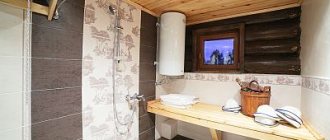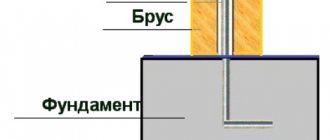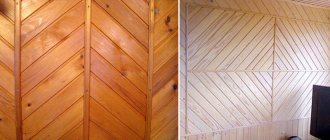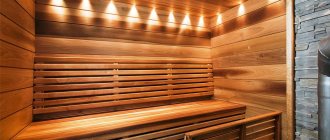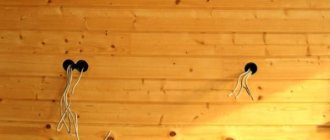Lining is a type of lumber that is similar to edged wood. The only difference is the presence of longitudinal grooves, which ensure adhesion of the elements without the formation of gaps. Finishing from lining creates a microclimate in the room suitable for relaxation, while its arrangement does not require experience in finishing, as when working with wood. To obtain the expected result, it is enough to follow the step-by-step instructions and select materials in accordance with accepted rules.
Material selection
Before you start work, you need to determine which lining to choose for the bathhouse. Wood is usually used. The main difference between the lining is the presence of a tongue-and-groove connection, thanks to which the boards fit more tightly to each other. This allows you to get a smooth and even surface, without cracks or gaps.
When choosing, first of all, you should decide on the type of wood. Hardwoods that are resistant to humid environments are mainly used. If you still want to make cladding from coniferous trees, it is important to choose species that do not emit resin. Not only will it stick to the skin, but it can also burn.
You can choose from the following breeds:
- Aspen . It tolerates temperature changes and high humidity well, and is easy to process. It has a white, slightly silvery color, with growth rings visible on the surface. Fresh aspen is soft, but becomes stronger. It must be sanded periodically when the lining becomes dull.
Aspen paneling Source saunainter.com
- Linden . When choosing which wood is best to cover a steam room in a bathhouse, many do not ignore linden. The material is easy to process, it is durable and beautiful - light, matte. At high temperatures it releases useful microparticles. However, linden has a serious drawback: upon contact with iron, the latter oxidizes and begins to rust.
- Alder . It has low thermal conductivity, a pleasant smell and a positive effect on health. Alder is often used in the decoration of country houses, but its price is high.
- Oak _ Durable and strong, difficult to process. It does not rot and does not need to be further processed for protection. It has a high price.
- Abashi or African oak . Durable, does not deform over time and is easy to process. This is an expensive cladding option, and African oak is also rare. But the service life of an abashi is calculated in decades.
Abashi trim Source tildacdn.com
- Larch . When deciding what can be used to line the inside of a bathhouse inexpensively, they most often stop at this. Unlike many conifers, it does not emit resin, tolerates temperature differences well, has a uniform structure, and only becomes stronger over time. Does not rot and does not attract insects. When heated, it releases useful antiseptic substances.
- Pine . Available in various shades of beige and brown, it usually has a reddish tint and pronounced growth rings with resin canals. It does not deform from mechanical damage, is easy to process - the surface is even and smooth. However, pine is not used for the steam room because of the resin it produces - it is used to line the dressing room, rest room and locker room. If you want to upholster the steam room with pine, before using it you need to heat it several times so that all the resin comes out.
- Cedar . It has different shades - from light beige to coffee. It withstands humidity and temperature changes and lasts a long time. Disadvantages include the high price and the need to treat the wood with an antiseptic. In addition, cedar may begin to secrete resin after a few years.
Finishing from Canadian cedar Source saunaland.ru
See also: Catalog of companies that specialize in finishing materials and related work
- Hemlock or Canadian hemlock . When choosing what to cover a bathhouse with, you should not ignore this wood. Canadian hemlock is durable, tolerates high humidity and temperature well, and is not subject to rot or deformation. When heated, it releases beneficial substances.
The appearance of the lining is extremely important: the boards must be smooth, without defects, holes and knots. It is better to choose the first or highest grade and eurolining. The latter has a smooth surface, is coated with an antiseptic and has special holes through which ventilation is provided.
Step-by-step guide to covering a bathhouse with film and clapboard
Sheathing begins with calculating the amount of materials and choosing one of them. Aluminum foil is used as a vapor barrier and heat repellent. This material is not recommended for use in residential premises, as it emits substances that are unsafe for humans in large quantities. But people visit a bathhouse or sauna for several hours and not every day. Therefore, there will be no harm from such finishing. In addition, the foil section will be hidden in the wall by the final finishing - clapboard.
The creation of sheathing and installation of heat insulation begins after the installation of all communications and ventilation is completely completed.
The lining is chosen with a thickness of 12.5 mm, a working width of about ten cm. The length of the panel ranges from 2 to 6 m, depending on the width of the wall. Or its height if vertical laying of panels is planned.
Initially, a sheathing is created, insulation is laid and a vapor barrier is installed. After this, holes are cut in the insulation opposite the ventilation windows. Upon completion of these manipulations, they proceed to laying the lining in the chosen method.
We recommend reading:
Why and how to make a good vapor barrier for a roof?
Protection from moisture and heat loss
Before finishing the room, it will have to be protected from condensation and heat loss. For this:
- Film waterproofing is installed or a special composition with similar properties is applied to the wall. The vapor barrier film is fixed using nails on wooden walls or slats on stone and brick walls.
- Install the timber sheathing. The pitch between the axes should be equal to the size of the piece of heat-insulating material. The height should be equal to the thickness of the insulation.
- Place the insulation in the recesses of the sheathing with an overlap of 1 cm.
- Foil is attached to the lathing slats. Its pieces are placed overlapping, the joints are taped with aluminum tape. To fix the film, they often choose either small nails or a construction stapler.
- A counter-lattice is attached over the lathing slats and the foil fixed on them. It follows the contours of the first sheathing and creates a gap between the foil and the finishing.
At this stage, the main thing is not to confuse the aluminum film with the vapor barrier foil, which protects the insulation from the formation of condensation on the wall of the building. If you neglect this step, the insulation will become damp due to contact with cold air from outside after the walls freeze. A damp insulator will become a breeding ground for mold and harmful bacteria.
Ventilation
After installing the insulation, ventilation holes are cut in it according to the size of the ventilation windows existing in the room. Initially, it is recommended to make one hole under the ceiling of the bathhouse, and another one at the bottom. This approach ensures better air circulation and rapid removal of excess moisture after bath procedures. It is best to force air circulation in the bathhouse, that is, install not only a shaft, but also a fan on it to blow through the rooms.
Creating a sheathing
Lathing over the foil should not damage the film. Therefore, it is advisable to clean the slats in advance from burrs and knots, and also to file the corners on them at 45 degrees. When installing the lathing in a steam room or dressing room, you will have to follow a number of rules:
- The batten should not reach another wall or ceiling. Otherwise, when heated, the wood will expand, which will lead to swelling of the entire counter-lattice mesh.
- Installation of the sheathing is carried out level, if thermal insulation has not been completed before. When using insulation, a level is not needed - the bottom sheathing is already installed in compliance with the geometry of the room.
- When installing the sheathing on the ceiling, you can use hangers - metal pins that are fixed to the ceiling. Their use makes it possible to artificially lower the ceiling in the bathhouse and reduce the cost of heating the room during operation. Suspensions are also installed by level; due to the specifics of the room, you need to choose those that are not susceptible to rust - aluminum, galvanized, etc.
- The optimal lathing pitch is 50 cm, this distance is enough to fix the lining. If the previous sheathing is wider than the required distance, you will have to add additional strips. In this case, they will have to be fixed only in the corners to the previous sheathing, and not to the insulation.
- For fastening the counter-lattice, self-tapping screws or stainless steel nails 9-10 cm long are best suited. Drive them in so that the heads are flush with the board. If you ignore this step, you won’t be able to lay the lining evenly because the caps will get in the way.
It is better to drive the fasteners at an angle from top to bottom, and not perpendicular to the wall. This approach ensures that the wood remains in place even as it expands due to heat.
Fastening the lining
Before attaching to the walls and ceiling, the lining panels will need to be properly processed. Preparation includes:
- Trimming the lining to the required size. Initially, the panel length is up to 6 m; few people will need such a large panel even with horizontal installation. The planks are cut with a jigsaw, the edges are polished so that there are no burrs or nicks.
- Drilling holes for self-tapping screws or fixing clamps. During installation, this will be more difficult to do, since you will have to be distracted by processing each panel, rather than installing them on the walls using the designer’s method.
After preparation is completed, the lining is laid in the chosen method. In this case, you will have to follow a number of rules:
- The gap to the floor should be about 2 cm. When fixing the lining to the ceiling, you need the same distance from the walls.
- You will have to cut off the ridge from the first plank, which is inserted into the groove. With the cut section, it is turned towards the nearest wall, the installation of the next plank is carried out in the groove of the first. The first plank is fixed against the wall with self-tapping screws, regardless of the chosen method of fastening.
- When using clamps and fixing them to the sheathing with mounting brackets, they must be driven in at an angle.
- The groove and that part of the main width that prevents the insertion of the lining into the space remaining between the adjacent plank and the wall are cut off from the final plank.
For better fixation when working, you can use a wooden or rubber mallet. The blows of this tool will ensure better adhesion of the panels to the sheathing, but will not damage the lining, unlike metal products.
Mounting options
Next, you need to choose how the lining will be attached. The planks are connected to each other by grooves, but they must also be attached to the sheathing.
You can do this in 2 ways:
- Using a clamper. This is a mounting bracket with 2-3 holes. It is put on the lining and fixed with nails, screws or staples. Installation begins from the center of the wall. Its main advantage is that the kleimer does not damage the lining.
- Using self-tapping screws or nails: the first ones are screwed in at an angle, the second ones are driven in. To avoid rust, it is better to choose galvanized or copper nails. Unfortunately, the metal will begin to rust, and leaks may also appear at the fastening sites.
Claymer for clapboard Source mainavi.ru
You can easily see how to properly line a bathhouse with clapboard from the inside with your own hands. The lining can be mounted horizontally or vertically. The first method is more suitable for saunas, where the humidity is low, the second - for Russian baths, where there is high humidity.
What to process
They try not to treat the steam room with anything. But those who would like to preserve the pristine purity of the wood and those who are not happy about the idea of making repairs in the coming years agree that in the steam room you can use impregnations based on vegetable (drying) oils to cover the lining - linseed, for example, or paraffin, or wax or a mixture of natural oil and wax.
Silicone, for Elcon lining
The Finns will also offer acrylic varnishes for saunas - they seem to be considered safe, but here everyone decides for himself whether he needs it or not.
In other rooms, you can use any compositions to protect wood - these are impregnations, varnishes, and paints (!more about painting here), and do not forget about antiseptics. Only in the washing room it is better to take those compositions that are suitable for bathrooms.
You can read more about lining processing here. Information about impregnated wood that has undergone industrial processing is presented here.
Beginning of work
Installation begins with determining the amount of material required. When calculating the perimeter of a room, it is important to subtract doors and windows. Don't forget about the ceiling - it is also lined with clapboard. It is also necessary to account for a small percentage of defects: the boards can break and are easy to cut incorrectly.
Lathing
The lining will be attached to the sheathing - a frame that runs along all surfaces of the bathhouse. The sheathing is made of bars, the cross-section of which has the shape of a square or rectangle. You can use slats from any wood. Even if the frame is made of coniferous wood, the resin will not leak out.
The minimum thickness of the frame should be 3 cm - this will allow air to easily pass between the wall and the sheathing. The thickness should be greater than the thickness of the insulating material so as not to interfere with air flow. It is better to choose slats with a width of at least 5 cm, so that it is more convenient to attach the lining to them.
Additional protection - special compounds and impregnations
Wood is a pleasant-smelling, natural material, which, in addition, gives the bathhouse the appropriate atmosphere of a rustic steam room. Using wood clapboard simplifies the procedure for finishing a bathhouse, and also saves material and costs - covering the walls and ceiling with clapboard will ultimately be cheaper than making a bathhouse from wood or covering it with untreated boards. But the finished finish has a significant drawback - without treatment with waterproofing compounds it will not last long: moisture passes through the connecting seams, settles in the grooves, reaches the vapor barrier material, accumulates on it and provokes the development of mold. To avoid this, you will have to treat the walls, floor and ceiling after finishing with a waterproofing solution.
Protective impregnation will extend the service life of both the finish and the bath itself. The main thing when applying it is to read the manufacturer’s instructions on the packaging and act in accordance with the algorithms specified therein. The safest and most effective waterproofing agents for baths are those containing wax. Water-based impregnations can also be used.
Video description
How to sheathe the ceiling and sheathe it is shown in the video.
When considering how to sheathe the inside of a bathhouse, it is important to consider the first steps. The first block is fixed at a distance of 10 cm from the wall, the distance between the others should be 40-60 cm. During work, you need to check with a level whether the sheathing is level.
If the ceiling needs to be lowered, the slats are mounted on metal hangers.
Installation process
Installation of lining on a wall or ceiling takes place in several steps. Before starting work, it is recommended to keep the lining in a bathhouse for a day so that the material “adjusts” to the atmosphere.
It is necessary to start covering the walls from the most inaccessible corner, the ceiling - from the entrance. The first board is placed with the tenon towards the corner - it will serve as a guide, and therefore it is important that it is installed level. The rest are attached to her. The boards fit tightly to each other, leaving no gaps. The last board will need to be cut and adjusted to width. You will also need to attach the cut boards around the door and window.
At the end of the work, the walls can be impregnated with protective agents. When choosing, it is important to clarify whether they are suitable for a bath.
Lathing on the walls Source remontnik.ru
What are finishing nails?
This is the name for nails with a small cylindrical head, the diameter of which is only slightly larger than the diameter of the rod. They are designed specifically for fixing decorative trim, as they provide a hidden fastening. These nails are thin and, as a result, easily penetrate the wood without causing cracking. It’s easy to drown a small hat in the thickness of the material using a hammer.
Finishing nails
In the photo - the finishing nail next to the finisher
Characteristics
The rods of such hardware are smooth, with notches in the upper part, and range from 20 to 90 mm in length. The cap has an oval shape, and its height corresponds to the diameter of the rod. The diameter of the cap itself varies from 1.6 to 3.4 mm. The fasteners are made from low-carbon steel, and anti-corrosion compounds are used as a protective coating.
Unlike simple construction nails, finishing nails are not designed for high loads, since finishing materials are usually lightweight. They can only be used in structures that are not subject to shrinkage and mechanical bending or tearing loads. It is also undesirable to use them for temporary coverings: not a single tool makes it possible to pick up and pull out a nail due to the small head recessed into the wood. For the same reason, they cannot be reused.
NFL finishing nails
Galvanized finishing nails 1.8x40
Scope of application
Finishing nails are used not only for fastening lining; their scope of application is quite wide:
- furniture manufacturing;
- installation of small decor in interiors;
- decoration of window and door openings with platbands;
- fastening thin slats, glazing beads and skirting boards.
Some craftsmen use them when laying parquet and laminate flooring when they need to fix the planks, but since floor coverings are subject to constant mechanical stress, ordinary nails are more suitable here.
Driving the finishing nail. Using a finisher
Briefly about the main thing
Wooden lining for lining the inside of a bathhouse is an ideal finishing material. Deciduous trees are mainly used, since coniferous trees can begin to secrete resin.
Installation of the lining begins with determining the required amount of material and method of fastening. It is worth considering the small percentage of defects.
First, you need to attach a sheathing to the wall - a frame on which the lining will be supported. It is made from thick wooden slats.
Next, the insulation, waterproofing and vapor barrier are secured. When choosing materials, it is important that they are suitable for the bath and do not emit harmful substances when heated.
When installing the boards, they are fitted tightly to each other so that there are no gaps.
Ratings 0
Useful tips
And finally, a few tips that will ensure the reliability, durability and aesthetic appeal of wood cladding:
- Before installation, it is advisable to treat all wooden surfaces, including sheathing, with antiseptic impregnation, especially if clapboard is used to finish a wet room or external walls. This will prevent the spread of mold.
- When finishing interior spaces, materials must be kept in them for two to three days for acclimatization.
- The lined surface can be painted, coated with oil, wax, varnish, or stain. Pre-priming will reduce the consumption of varnish or paint.
Preparing the necessary tools
For lining the inside of the bathhouse you will need the following tool:
- Chainsaw or electric saw;
- Drill or hammer drill;
- Hand saw and jigsaw;
- Screwdriver;
- Axe;
- Plane;
- Hammer;
- Doboynik;
- Clamps and clamps;
- Construction stapler.
Advice. To make plating faster and easier, experts recommend using a pneumatic tool.
For driving at an angle, the tip of the air gun has a rectangular groove. When working, the tip is placed on the edge of the tenon. The groove prevents the tip from slipping when moving along the ridge of the tenon.
Subtleties of finishing inside the bath
- Do not mount the lining horizontally in the washing room and steam room. Splashes of water will enter the lock, and the lining will quickly darken. But if the design requires horizontal fastening, then the tenon should point upward.
- All fasteners must be taken with a zinc coating, since iron will quickly rust if exposed to moisture.
- All fastening corners and strips at the top need to be slightly sharpened at the bottom, so the water droplets will go down faster.
- The planks are attached 4-5 cm from the base, so as not to block the ventilated gap.
- Consider a ventilation system in the bathhouse, so the moisture will evaporate faster and the lining will last longer.
- If the lining turns black, it must be immediately treated with bleaching compounds, for example, Senezh Sauna
We looked at how to do the interior decoration of a bathhouse with clapboards with your own hands. By following all the techniques and watching the thematic video in this article, even a beginner will be able to do the job with his own hands.
Useful tips
And finally, a few tips that will ensure the reliability, durability and aesthetic appeal of wood cladding:
Before installation, it is advisable to treat all wooden surfaces, including sheathing, with antiseptic impregnation, especially if clapboard is used to finish a wet room or external walls. This will prevent the spread of mold.
When finishing interior spaces, materials must be kept in them for two to three days for acclimatization.
The lined surface can be painted, coated with oil, wax, varnish, or stain. Pre-priming will reduce the consumption of varnish or paint.

